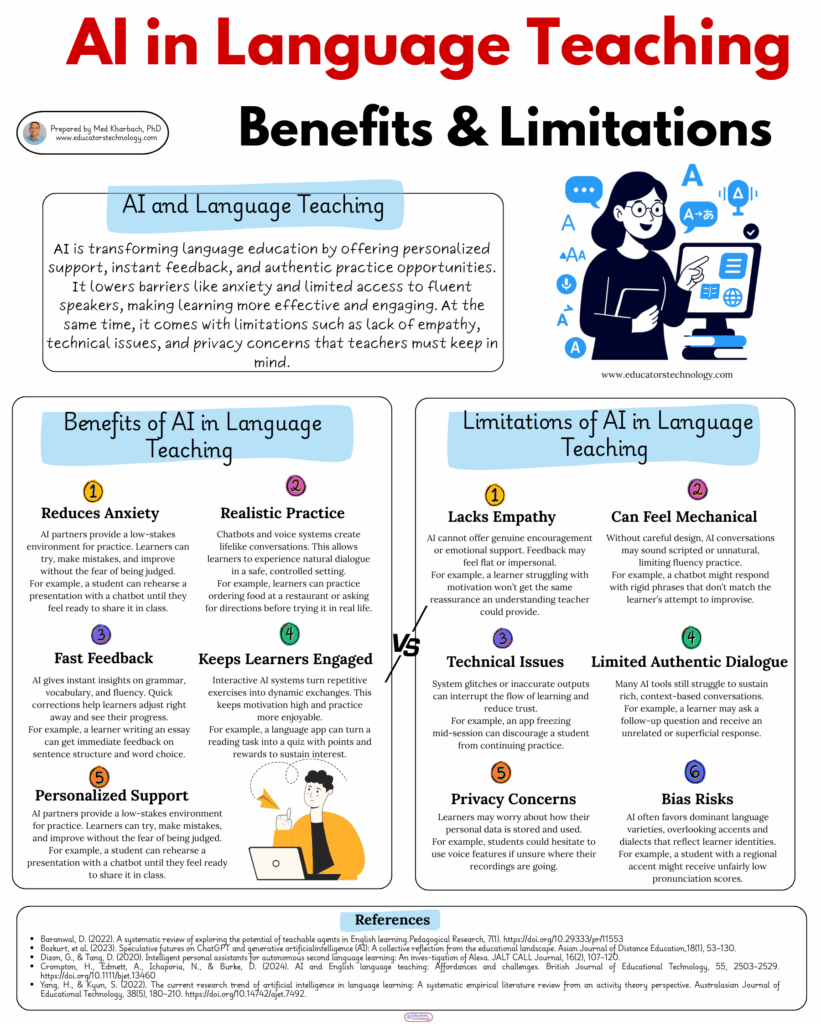I’ve long been an advocate of using AI in education. For years, we’ve heard luddite voices painting AI as a monster that would rob teaching of its essence. But those voices are fading fast. AI is proving to be the next electricity in education, a force that changes not just how we work but what’s possible in the first place.
My motto has always been: use AI and use it boldly, but also ethically and responsibly.
Earlier today I shared a research‑backed guide on the use of AI in language teaching. As a follow‑up, here’s an expanded version highlighting both the affordances and the limitations of AI in this field.
From lowering student anxiety and providing personalized feedback to concerns about empathy, authenticity, and privacy, this visual gives a balanced overview of where AI works best and where caution is needed.
For those who want to go deeper, I’ve included references to peer‑reviewed research at the bottom. AI is not a passing trend. It’s a permanent shift. The question is no longer if we should use it, but how well we can put it to work for learners.
Benefits of Using AI in Language Teaching
AI is opening new possibilities for language education. From reducing learner anxiety to providing fast feedback and personalized support, it helps create more engaging, flexible, and effective learning experiences.
1. Reduces Anxiety
AI partners provide a low‑stakes environment for practice. Learners can try, make mistakes, and improve without the fear of being judged. For example, a student can rehearse a presentation with a chatbot until they feel ready to share it in class.
2. Realistic Practice
Chatbots and voice systems create lifelike conversations. This allows learners to experience natural dialogue in a safe, controlled setting. For example, learners can practice ordering food at a restaurant or asking for directions before trying it in real life.
3. Fast Feedback
AI gives instant insights on grammar, vocabulary, and fluency. Quick corrections help learners adjust right away and see their progress. For example, a learner writing an essay can get immediate feedback on sentence structure and word choice.
4. Keeps Learners Engaged
Interactive AI systems turn repetitive exercises into dynamic exchanges. This keeps motivation high and practice more enjoyable. For example, a language app can turn a reading task into a quiz with points and rewards to sustain interest.
5. Personalized Support
AI adapts to each learner’s level and needs. It provides targeted practice and feedback, ensuring steady and meaningful progress. For example, a struggling reader might receive simplified texts, while an advanced learner is challenged with more complex passages.
Limitations of of Using AI in Language Teaching
While AI offers powerful benefits, it also comes with clear challenges. From lack of empathy to privacy concerns, these limitations remind us that AI should support, not replace, the human touch in language education.
1. Lacks Empathy
AI cannot offer genuine encouragement or emotional support. Feedback may feel flat or impersonal.
For example, a learner struggling with motivation won’t get the same reassurance an understanding teacher could provide.
2. Can Feel Mechanical
Without careful design, AI conversations may sound scripted or unnatural, limiting fluency practice. For example, a chatbot might respond with rigid phrases that don’t match the learner’s attempt to improvise.
3. Technical Issues
System glitches or inaccurate outputs can interrupt the flow of learning and reduce trust.
For example, an app freezing mid‑session can discourage a student from continuing practice.
4. Limited Authentic Dialogue
Many AI tools still struggle to sustain rich, context‑based conversations. For example, a learner may ask a follow‑up question and receive an unrelated or superficial response.
5. Privacy Concerns
Learners may worry about how their personal data is stored and used. For example, students could hesitate to use voice features if unsure where their recordings are going.
6. Bias Risks
AI often favors dominant language varieties, overlooking accents and dialects that reflect learner identities. For example, a student with a regional accent might receive unfairly low pronunciation scores.


References
- Baranwal, D. (2022). A systematic review of exploring the potential of teachable agents in English learning.Pedagogical Research, 7(1). https://doi.org/10.29333/pr/11553
- Bozkurt, A., Xiao, J., Lambert, S., Pazurek, A., Crompton, H., Koseoglu, S., Farrow, R., Bond, M., Nerantzi, C.,Honeychurch, S., Bali, M., Dron, J., Mir, K., Stewart, B., Costello, E., Mason, J., Stracke, C. M., Romero-Hall, E., Koutropoulos, A., … Jandrić, P. (2023). Speculative futures on ChatGPT and generative artificialintelligence (AI): A collective reflection from the educational landscape. Asian Journal of Distance Education,18(1), 53–130.
- Dizon, G., & Tang, D. (2020). Intelligent personal assistants for autonomous second language learning: An inves-tigation of Alexa. JALT CALL Journal, 16(2), 107–120.
- Crompton, H., Edmett, A., Ichaporia, N., & Burke, D. (2024). AI and English language teaching: Affordances and challenges. British Journal of Educational Technology, 55, 2503–2529. https://doi.org/10.1111/bjet.13460
- Yang, H., & Kyun, S. (2022). The current research trend of artificial intelligence in language learning: A systematic empirical literature review from an activity theory perspective. Australasian Journal of Educational Technology, 38(5), 180–210. https://doi.org/10.14742/ajet.7492.







